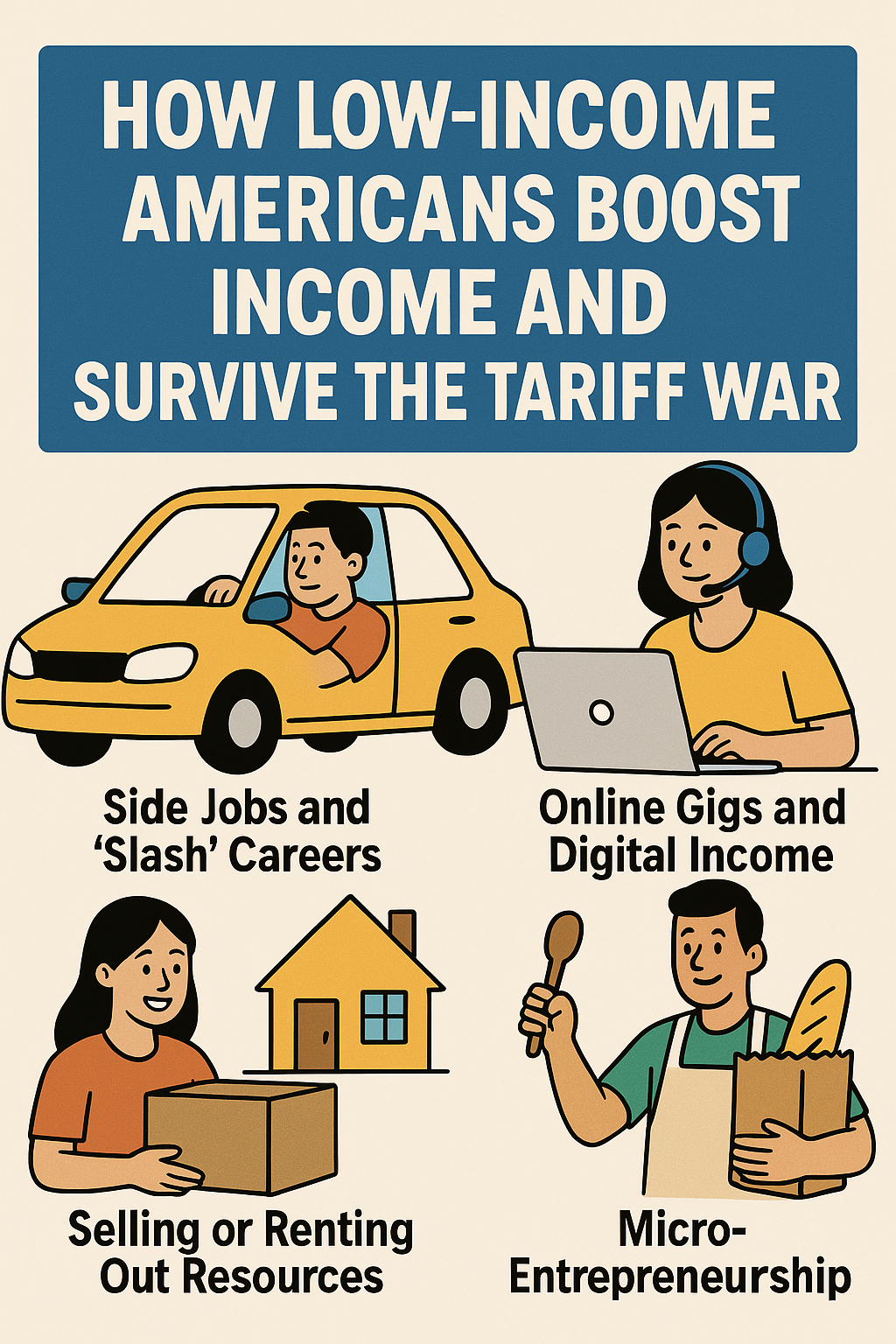🇺🇸 How Low-Income Americans Boost Their Income and Survive the Tariff War
In recent years, the U.S. has engaged in escalating trade tensions with countries like China, imposing heavy tariffs on imported goods. While the original intention is to “protect domestic industries,” the reality is that ordinary consumers bear the cost—especially low-income households.
With the cost of living rising sharply, many low-income Americans are not just trying to cut spending, but also actively seeking ways to increase their income. This article explores in detail how they are surviving, adapting, and even finding ways to thrive during this crisis.
🔥 Why Are Low-Income Americans the Biggest Victims of the Tariff War?
Tariffs act as consumption taxes. They raise the prices of imported goods—often the very affordable essentials low-income families depend on. The result:
- Living costs rise (food, clothes, appliances)
- Wages stagnate or don’t keep up
- Jobs become scarce (as small businesses cut costs or shut down)
So beyond saving money, the focus shifts to earning more.
💼 How Are They Increasing Income During the Tariff Crisis? 7 Real-World Strategies
1️⃣ Side Jobs and “Slash” Careers
Many take up a second job or side hustle to add cash flow, such as:
| Job Type | Examples |
|---|---|
| Transportation | Uber, Lyft, Doordash deliveries |
| Cleaning Services | Housekeeping, car wash, gardening |
| Night Shifts | Gas stations, retail stores, diners |
| Childcare/Tutoring | Babysitting, after-school tutoring |
📊 According to Pew, over 40% of low-income Americans had at least one side hustle in 2023.
2️⃣ Online Gigs and Digital Income
The internet offers many ways to earn small but meaningful income without advanced education:
- Online surveys (Swagbucks, InboxDollars)
- Remote data entry or customer service
- Sell handmade goods on Etsy
- YouTube or TikTok channels (daily life, skills, tips)
- Freelance gigs on Fiverr or Upwork (resume writing, design, translation)
💡 Pro tip: Choose gigs that help you build skills and a portfolio for future growth.
3️⃣ Selling or Renting Out Resources
Turning unused items or space into income:
| Resource | Monetization Idea |
|---|---|
| Car | Rent on Turo, drive for hire |
| Spare Room | Airbnb, rent to students or travelers |
| Old Items | Sell on Facebook Marketplace, Craigslist |
| Tools/Equipment | Rent out cameras, audio gear, power tools |
🔁 Turning “dead assets” into cash is a smart crisis strategy.
4️⃣ Government and Nonprofit Assistance: Not Just “Survival Money”
Government aid frees up income so families can redirect time or effort into earning:
- EITC & Child Tax Credit: Can result in thousands in tax refunds
- SNAP (Food Stamps): Saves hundreds on groceries
- WIC: Assists families with babies (formula, baby food)
- Free training programs: From local workforce boards or Google Career Certs
- Job coaching & emergency cash from nonprofits and churches
📌 Using public support smartly is not weakness—it’s strategy.
5️⃣ Micro-Entrepreneurship: Turning Side Hustles into Small Businesses
Some scale up their side gigs into self-employment:
- Selling home-cooked meals (e.g. burritos, boxed lunches)
- Mobile services (nails, haircuts, tutoring)
- Reselling or refurbishing goods at flea markets
- Starting an e-commerce store (shipping orders from home)
📈 It’s not easy, but it offers more autonomy and income potential.
6️⃣ Upskilling: Investing in Higher-Income Potential
Even in hard times, some choose to level up:
- Night classes (nursing, auto repair, electrician training)
- Online certifications (Google, Coursera, AWS, Python)
- Workforce programs (free tech or trade skills from state agencies)
🧠 Skills are inflation-proof and recession-resistant assets.
7️⃣ Shifting the Money Mindset: Value Over Time
This crisis is also teaching many to rethink income:
- Can I monetize skills, not just labor hours?
- Can I create multiple income streams, not rely on one job?
- Can I build a personal brand, product, or digital asset?
💬 Many creators, freelancers, and entrepreneurs began just like this—with a side hustle.
✊ Conclusion: Low-Income ≠ Low Potential
While the tariff war has worsened financial stress, it has also forced a mindset shift. Many low-income Americans are exploring new opportunities, learning new skills, and finding new ways to survive and succeed.
They are not just cutting back—they’re pushing forward.
They face challenges—but show resilience.
They may be overlooked—but they are fighting back with intelligence and grit.
If government policies can’t protect them first, they must protect themselves through learning, adapting, and hustling—with dignity and determination.

